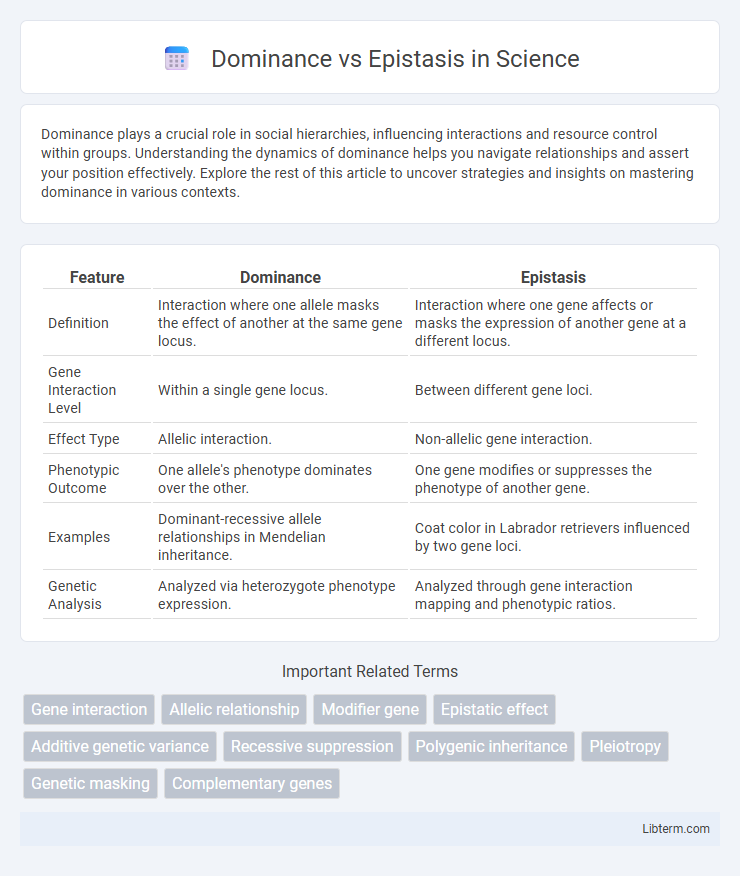Dominance plays a crucial role in social hierarchies, influencing interactions and resource control within groups. Understanding the dynamics of dominance helps you navigate relationships and assert your position effectively. Explore the rest of this article to uncover strategies and insights on mastering dominance in various contexts.
Table of Comparison
| Feature | Dominance | Epistasis |
|---|---|---|
| Definition | Interaction where one allele masks the effect of another at the same gene locus. | Interaction where one gene affects or masks the expression of another gene at a different locus. |
| Gene Interaction Level | Within a single gene locus. | Between different gene loci. |
| Effect Type | Allelic interaction. | Non-allelic gene interaction. |
| Phenotypic Outcome | One allele's phenotype dominates over the other. | One gene modifies or suppresses the phenotype of another gene. |
| Examples | Dominant-recessive allele relationships in Mendelian inheritance. | Coat color in Labrador retrievers influenced by two gene loci. |
| Genetic Analysis | Analyzed via heterozygote phenotype expression. | Analyzed through gene interaction mapping and phenotypic ratios. |
Understanding Genetic Interactions: Dominance vs Epistasis
Dominance occurs when one allele masks the expression of another at the same gene locus, whereas epistasis involves interactions between alleles at different gene loci that affect phenotypic outcomes. Understanding genetic interactions requires distinguishing dominance, which affects single-gene traits, from epistasis, which influences polygenic traits by modifying or suppressing gene effects. Epistasis can lead to complex inheritance patterns, making it crucial for advanced genetic analysis and breeding strategies.
Defining Dominance in Genetics
Dominance in genetics refers to the phenomenon where one allele masks the expression of another allele at the same locus, influencing the phenotype. This concept is fundamental for understanding Mendelian inheritance patterns, where dominant alleles dictate traits regardless of the presence of recessive counterparts. Differentiating dominance from epistasis, which involves interactions between alleles at different loci, is crucial for interpreting complex genetic traits and predicting phenotypic outcomes.
Exploring Epistasis: Beyond Simple Dominance
Epistasis occurs when the effect of one gene is modified by one or several other genes, emphasizing complex gene interactions beyond simple dominance where one allele masks another. This phenomenon highlights the multifaceted nature of genetic expression, affecting phenotypic outcomes through mechanisms like complementary, duplicate, or inhibitory epistasis. Understanding epistasis is crucial for interpreting genetic variation, predicting traits, and advancing fields like evolutionary biology and genetic engineering.
Molecular Basis of Dominance
Molecular basis of dominance arises when a functional allele produces sufficient gene product to mask the effect of a nonfunctional allele in heterozygotes, often due to enzyme activity thresholds. Epistasis involves interactions between different genes where one gene's expression alters or suppresses the expression of another gene, affecting phenotypic ratios. Unlike dominance, which concerns alleles at the same locus, epistasis occurs between different loci and influences complex traits through gene-gene interactions.
Types of Epistatic Interactions
Epistasis occurs when the effect of one gene is modified by one or more other genes, contrasting with dominance where interactions occur between alleles of the same gene. Types of epistatic interactions include recessive epistasis, where two recessive alleles mask the effect of a dominant allele at a different locus, and dominant epistasis, where a dominant allele at one locus masks alleles at a second locus. Other forms include duplicate recessive epistasis, duplicate dominant epistasis, and dominant and recessive epistasis, each involving specific allele interactions that alter phenotypic expression.
Phenotypic Outcomes: Dominance Compared to Epistasis
Dominance occurs when one allele masks the expression of another at the same gene locus, resulting in a predictable phenotypic ratio such as the classic 3:1 in Mendelian inheritance. Epistasis involves interactions between alleles at different loci, where one gene can suppress or modify the phenotypic effect of another, often producing modified Mendelian ratios like 9:7 or 13:3 depending on the epistatic relationship. Phenotypic outcomes in dominance typically reflect allele hierarchy at a single gene, whereas epistasis reveals complex gene network interactions influencing trait expression.
Dominance and Epistasis in Inheritance Patterns
Dominance refers to the interaction between alleles at a single gene locus where the dominant allele masks the expression of the recessive allele in heterozygous individuals. Epistasis involves interactions between genes at different loci, where one gene can suppress or modify the expression of another gene, affecting phenotypic ratios. Inheritance patterns influenced by dominance typically follow Mendelian ratios, whereas epistatic interactions lead to modified phenotypic ratios that deviate from classic Mendelian expectations.
Genetic Mapping and the Role of Epistasis
Dominance affects genetic mapping by influencing phenotypic ratios of alleles at a single locus, complicating the detection of quantitative trait loci (QTL) due to non-additive gene effects. Epistasis plays a crucial role in genetic mapping by representing interactions between multiple loci, which can mask or modify the effects of individual genes and thus impact the accuracy of QTL identification. Understanding epistatic interactions enhances the resolution of genetic maps and improves the prediction of complex trait inheritance through more precise modeling of gene networks.
Implications for Breeding and Genetic Engineering
Dominance and epistasis significantly influence trait expression, affecting selection efficiency in breeding programs by altering phenotypic ratios and genetic variance. Understanding dominance enables breeders to predict heterozygote performance, while epistasis reveals complex gene interactions that can mask or enhance traits, guiding marker-assisted selection and gene editing strategies. Incorporating these genetic effects improves precision in developing desirable cultivars with optimized traits through targeted crossing and genetic engineering techniques.
Dominance and Epistasis: Key Differences and Applications
Dominance refers to the phenomenon where one allele masks the expression of another allele at the same locus, while epistasis involves interactions between alleles at different loci that affect phenotypic traits. Dominance is crucial in classical Mendelian genetics for predicting inheritance patterns, whereas epistasis plays a significant role in complex trait analysis and quantitative genetics. Applications of dominance include breeding and genetic counseling, whereas understanding epistasis aids in studying gene networks and evolutionary biology.
Dominance Infographic

 libterm.com
libterm.com